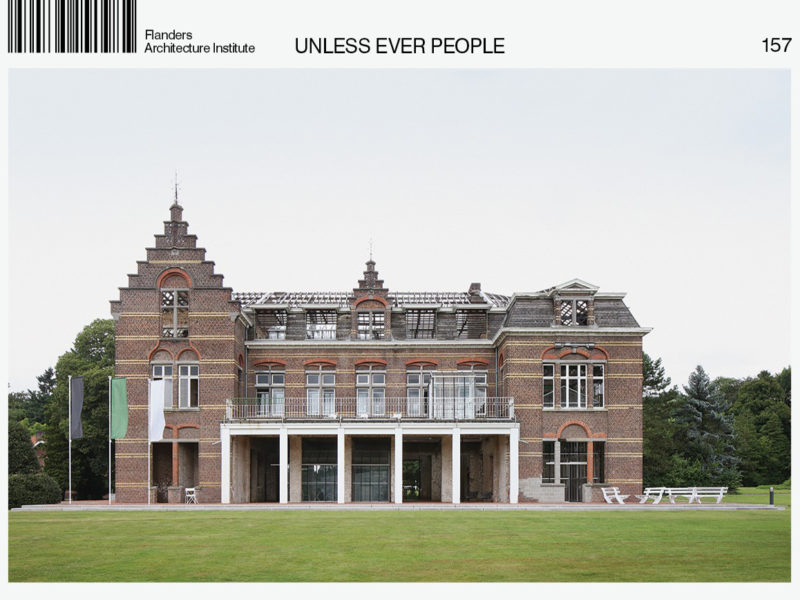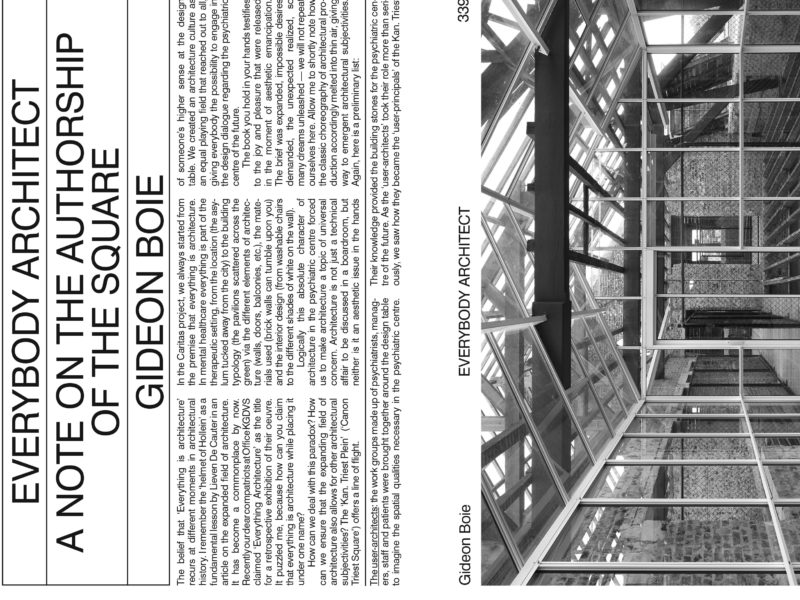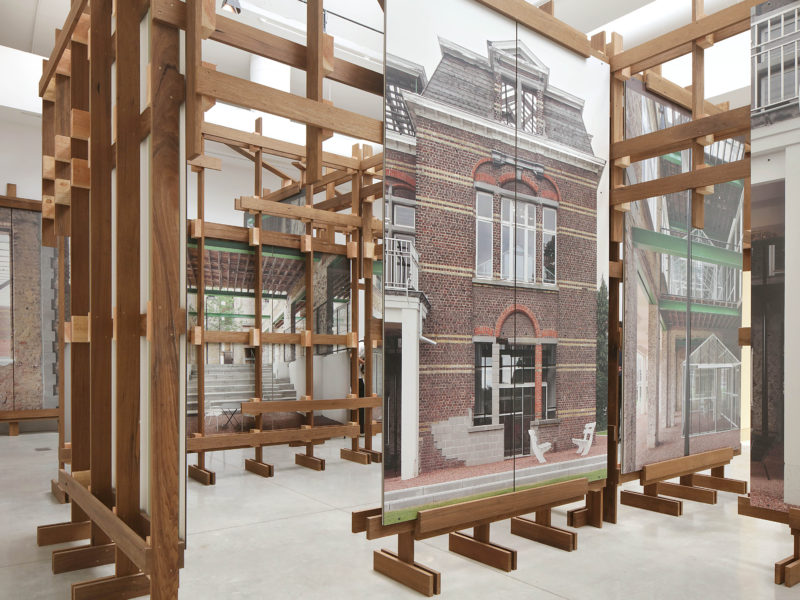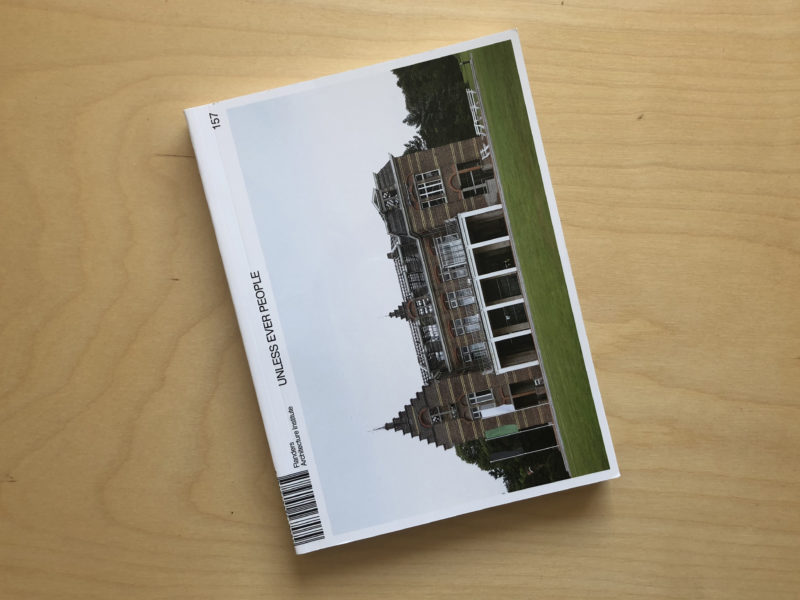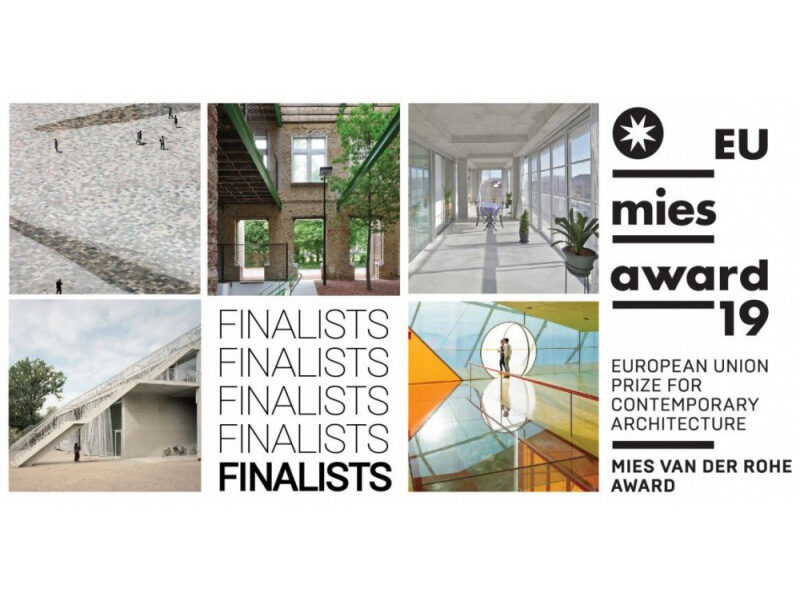Article
A Note on the Names of the Square
Gideon Boie
2018, VAi

The ‘Kan. Triest Plein’ (‘Canon Triest Square’) comes with a list of many names. The different authors in this book use various names to denote the very same building/idea/project, all depending on the phase they got involved at or simply due to a stubborn idée fixe. Keep in mind that the project definition came about by surprise and got redefined along the way, which means that the name has constantly been changing.
In the editing of the book we did not want to wipe out the different naming uses. Hidden in the many names of the same building/idea/project lies the short history of progressive insight which the people at the psychiatric centre were going through. Moreover, each name has a story to tell. Below is a non-exhaustive list.
1. Ever since we came together in workshops with psychiatrists, managers, staff and patients, in the late summer of 2014, the building was called by its original name. People talked about ‘Sint-Jozef’ (‘Saint Joseph’) as they did with the other buildings. The personification shows how the buildings were something special for the people working or staying at the psychiatric centre.
2. In everyday language it was usual to drop the prefix and simply call the building by its first name: ‘Jozef’ (‘Joseph’). The name unwittingly hints at the profanation of mental healthcare today, without erasing the Christian legacy that has been so important in the history of Belgian psychiatry and of the care provided to the weak more generally.
3. By the way: the profanation is also clear in the name-giving of the buildings constructed around the 1990s that refer to natural and/or maritime metaphors: ‘Klimop’ [‘Ivy’], ‘Dageraad’ [‘Dawn’], ‘Getijden’ [‘Tides’], ‘Branding’ [‘Breaking Wave’], Meander, ‘Kaap’ [‘Cape’], ‘Schorre’ [‘Marsh’], and so on.) All of these names indicate that something is about to happen while staying in the building.
4. In the project definition (January 2015) presented to the Board of Directors, the building was called the ‘Jozef Plein’ — with a blank space (unnecessary in Dutch spelling) to stress that the monumental outdoor structure would somehow function as a public space in the psychiatric centre.
5. The same name was used in the tendering process launched in March 2015 (specification number: PCC/INFRA/2015/002) but now written without a space while retaining the capital ‘P’: ‘JozefPlein’. The spelling is still incorrect, but the meaning remains the same.
6. The name ‘Jozef Huis’ (‘Joseph House’) can be found in a report dated 10 August 2015 (made by BAVO) of a meeting between management and architect. The reference to the Jozef Huis was dropped later as it contradicted the ambition to create an activity zone in the heart of the psychiatric centre, and not to create yet another house with doors to be opened and special functions attributed.
7. A newsletter was distributed in September 2015 describing the design proposal by architecten de vylder vinck taillieu while using the name ‘Jozef Huis’. Our mind was not made up yet. In the sketch version of the newsletter a note is written: ‘H. wants us to talk about Jozef Huis not Plein?’
8. The report of a management meeting dated 16 October 2015 (made by architecten de vylder vinck taillieu) again mentions ‘Jozef Plein’. Quote: ‘We are thinking about the name “JOZEFPLEIN”. Other suggestions: “jozefkamers” [“rooms of joseph”] — “jozefhuis” [“house of joseph”]. BAVO believes that the latter two do not cover the concept and scale, that they are too small. In the end, everyone feels good about the idea of the square, as well as about retaining the historical name.’
9. In the workshops organized in November 2015, the name of the project was explicitly discussed. The report (made by BAVO) notes: ‘The name has changed a number of times during the process: from Jozefplein to Jozefhuis … The right name may come at the end of the process. Meanwhile, the name changes tell us a lot about the changes in thinking we are experiencing in Caritas. There is enthusiasm for the call for a name! Names that have already been suggested: Jozefplein, Jozefhuis (“threshold is too high”), Jozef, Jef, our jozef? The Jef, our Jef?, Zef?, LOzef?, LOjef?, De Veranda [“The Porch”] (~De Rotonde [“The Rotunda”]) Openhuis [“Open House”], Vrijheid [“Freedom”], which in Swahili is “Ugura” [similarly, Duiventil (“Dovecote”) is “Kizimbi”], Vrijplaats [“Sanctuary”] …’
10. The report dated 13 March 2015 (made by architecten de vylder vinck taillieu) summarizes a meeting of all the contractors, engineers and safety advisers involved (Jona Trade, Juri NV, Van Baeveghem Electro, Charles Beaumont NV, UTIL and Techfix) under the heading ‘Project Sint-Jozef’.
11. The board of non-executive directors (June 2016) decided to name the building ‘Kanunnik Petrus Jozef Triest Plein’ (‘Canon Peter Joseph Triest Square’) to honour the founder of the psychiatric centre with the newly opened outdoor building — and perhaps also to use the correct Dutch spelling. The Kanunnik Petrus Jozef Triest Plein was opened in the presence of the Mother Superior Birgit of the Zusters van Liefde, the Mayor of Melle and the Mayor of Merelbeke.
12. The project has been named ‘Caritas’ by architecten de vylder vinck taillieu on their website and in various publications. As Caritas actually refers to the psychiatric centre as a whole, the project name rightly hints at the Jozef building figuring as pars pro toto. Dropping the postfix ‘plein’ also hints at the architects’ intention to consider it a specific place more than a square.
13. As of January 2018, the name of the Caritas Psychiatric Centre has changed to KARUS, after a merger with the Sint-Camillus Psychiatric Hospital in Sint-Denijs-Westrem (near Ghent).
14. At department level, the building ‘Lente’ (‘Spring’) was renamed Dageraad. The twin brothers Klimop/Dageraad were finally joined under the name ‘Anxiety and Mood Disorders’ — simply referring to the clinical image of the patients treated in the complex. The tiny Getijden building now houses the hospital school, while the former occupant ‘Day Care’ moved to the Schorre.
15. Over the years, people started to use a short version colloquially: ‘Kan. Triest Plein’. The name may be fixed by now, but it will certainly change in the future as the project is not yet completed, and perhaps never will be.
Lastly, all these name changes leave untouched the mysterious statue of Saint Joseph, standing hidden in the north façade. Is Sint-Jozef overlooking the psychiatric centre, watching the people go by or welcoming them all to the monumental outdoor structure? Perhaps all at once.
Chapter from the book: Gideon Boie, “A Note on the Names of the Square”, in Unless Ever People, Gideon Boie and architecten de vylder vinck taillieu, eds. (Antwerp: Flemish Architecture Institute, 2018), 170-173.
—
The book ‘Unless Ever People’ is published by the Flemish Architecture Institute in 2018 on the occasion of the 16th International Architecture Exhibition of Venice, curated by Yvonne Farrell and Shelley McNamara. who invited architects De Vylder Vinck Taiilieu and BAVO to present ‘Unless Ever People – Caritas for Freespace’ in the central exhibition.
Tags: Care, English, Psychiatry
Categories: Architecture
Type: Article
